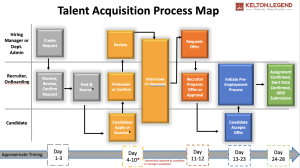The clock is ticking, but for whom — the recruiter or the hiring manager? Is it ticking for candidates, both passive and active, who may be trying to decide if now is the right time to change companies or careers? Or is time to fill simply a barometer — that is, something that merely reflects changes in circumstances or opinions.
As a young recruiter, I recall being introduced to time to fill by a director who would move heaven and earth to impress our C-suite. The precise calculation from the date that a req was first posted to when it was marked as filled was a primary driver of our recruiting model. I watched members of our team — some new, others more experienced — race to their desk and hit closed/filled to stop the clock.
Speed was the primary concern. It was more important than considering the actual process, steps, conflicting priorities, resources, or managers.
As I advanced in my career, I learned more about TA as a strategic function, and the importance of the process to achieve goals. I began to see time to fill in a completely different light. It became not just a numerical value but more about the:
- Effectiveness of the TA strategy
- Efficiency of the TA process
- Quality of relationships between managers and recruiters
- Alignment of resources
- Talent market conditions
A Problematic Numbers Game
Time to fill is not about recruiter performance, because recruiters rarely, if ever, have complete autonomy for the entirety of the hiring process. And so the inclusion of this metric in recruiter performance reviews is misplaced.
Time to fill is also not ultimately about manager availability, decisiveness, or commitment to an equitable hiring process. Though those factors are critically important, the TA process isn’t just about the manager.
Let’s also consider candidate responsiveness. I’ve often heard TA professionals complain, especially in a difficult labor market, that jobs are posted and candidates aren’t applying. I remind them that candidates are under no obligation to apply to your reqs.
So what is time to fill? Some organizations measure from req posted to a variety of end points: offer acceptance, clearing pre-employment contingencies by the candidate, or the candidate’s start date.
That final milestone has always been problematic. Candidates who are currently working, awaiting final clearance prior to resigning, or who wish to take some time off prior to starting a new job will destroy the time to fill metric.
The final quark in this numbers game is the removal of weekends from the metric, as if the average of three to five weekends that were included somehow dramatically skewed the data. This practice has always been peculiar to me because we allow jobs to remain posted, and candidates apply, over the weekend — but we want weekends removed to make the data look better.
It’s Not Really About the Number
Rather than considering a lower time to fill as its own goal, you’d be better off viewing it as a measure of the overall wellness of your TA strategy and process.
Is your process well defined? Are you optimizing the right resources? Have you sought to remove unnecessary bureaucracy? Are managers and recruiters aligned as partners and not adversaries? Does your company’s reputation as an employer continuously attract a deep and competitive candidate pool? And last but not least, are you consistently and accurately measuring the defined start and end points of your process.
For the record, 30 to 45 days is the metric that I have most often seen as an average. The number may be reduced if organizations have a healthy talent pipeline to draw from and minimal hiring requirements. It could also be elongated due to a tight labor market, hiring process inefficiencies, and organizational constructs (like an unnecessarily layered interview process).
It’s reasonable to expect that roles that are industry-specific or situated in the upper level of the organization will take well beyond 45 days to fill, possibly three to five months. It’s also important to mention that if you find yourself routinely removing certain reqs to make your numbers look good — don’t. Fix what’s wrong or include the appropriate narrative to explain the real issues.
In other words, use the number as a means to identify and improve issues, not as an isolated measurement of success.
